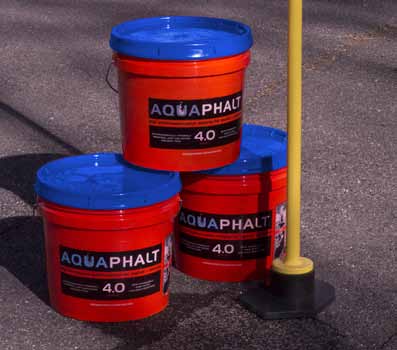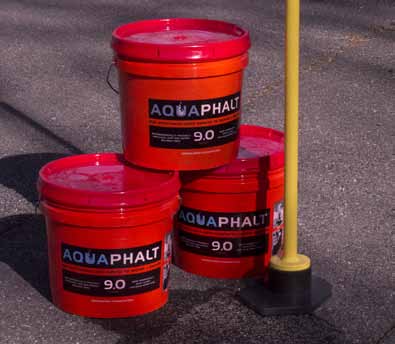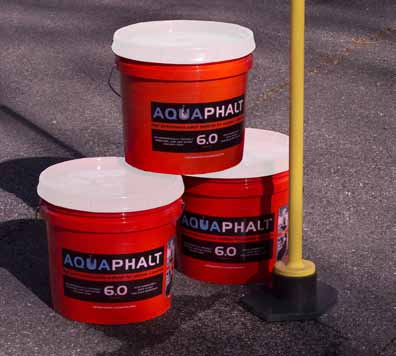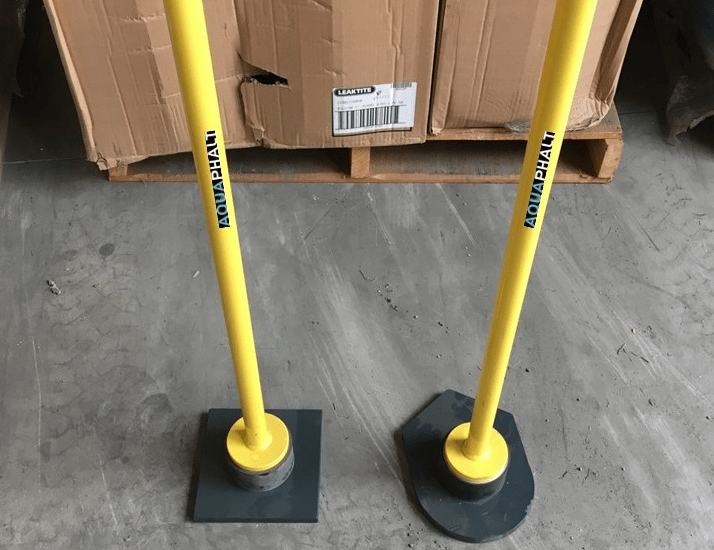Products
A Wide Range of Aggregate Sizes to Meet Clients' Needs


Aquaphalt 4.0 (Fine)
Use & Repair Thickness
Designed for thin repairs, approximately 0.5 to 1 inch depth (i.e. under 1 inch).
Suitable for large cracks, trip hazards, thin concrete overlays, and shallower asphalt repairs where using a coarser aggregate would be too “rough.”
Characteristics / Strengths
Because of its fine aggregate, the patch is smoother and more compatible for shallow surfaces.
Helps to avoid “voids” or gaps in thin patches (as a coarser mix might leave voids or not compact fully).
Often used as a top material over coarser fill in a “fill then cap” strategy: e.g. a coarse layer below, then 4.0 on top for a polished final surface. Many users use 6.0 underneath and finish with 4.0.
Limitations / Considerations
Not suited for deep repairs — using 4.0 for deep holes may lead to excessive settlement or lack of structural integrity.
In deeper patches, compaction can be less effective if the aggregate particles are too small or too “packed.”
May cost more per volume for the same depth, since more material may be needed to fill deeper areas.






Aquaphalt 9.0 (Course)
Use & Repair Thickness
Designed for very deep repairs, generally 2 inches or more (or “2+” repairs).
Acts as a base or structural fill in large roadway damage, before potentially topping with a finer aggregate layer.
Characteristics / Strengths
The coarsest aggregate mix—good for structural strength, filling large voids, and serving as a durable base.
Excellent when large material removal or deep degradation has occurred and a more robust “backfill” is needed.
In many deep repairs, 9.0 might be placed first, and then capped by 4.0 or 6.0 to get a smoother final surface. Some practitioners question using 9.0 alone because its coarseness may affect ride quality or surface smoothness.
Limitations / Considerations
Because of its large aggregate size, compaction at shallow depths may be harder or less uniform.
The surface might be rougher if not capped or smoothed with finer material.
In shallow settings, using 9.0 could result in “voids” or inability to tamp fully around the larger pieces.
Aquaphalt 6.0 (Medium)
Use & Repair Thickness
Intended for repairs of 1 inch or greater depths (i.e. 1"+).
A general-purpose, all-around variant, covering the majority (> 90%) of repair jobs.
Characteristics / Strengths
Balanced aggregate size — coarse enough to provide structural strength and good compaction, yet fine enough to compact well in moderate-depth patches.
Because it suits many common repair depths, inventory-wise it’s the most popular and “go-to” option for contractors.
Retains the advantages of the Aquaphalt system: water-activated, fast curing, usable in various weather, etc.
Limitations / Considerations
In very shallow repairs (< 1 inch), it may not surface-smooth as well as 4.0, and could appear “rougher.”
In very deep repairs, 6.0 may not provide optimal stability compared to a coarser base layer (e.g. 9.0) as a first fill.
Hand Tampers
Type 1: Light/Standard Hand Tamper
A basic tamper model intended for typical patch repair work using Aquaphalt material (for depths of ~0.5″ to ~2″, general patches).
The ~17 lb weight makes it manageable for a single technician doing smaller repairs or where mobility is important.
Equipped with shock-absorbing mount (neoprene rubber) to reduce vibration transfer into the operator’s body (forearms/back) — helpful for reducing fatigue and risk of injury, especially when doing many patches.
Cushion grip handle improves ergonomics and grip when working in damp/dirty conditions.
Ideal for: Smaller potholes, utility cuts, sidewalk/driveway patches, areas accessible by hand. Especially useful where heavy compaction equipment (plate compactor) is not practical or cost-effective.
Type 2: “Heavy-Duty or Extended Reach Hand Tamper”
Geared toward larger repairs — think bigger potholes, roadway repair, deep utility cuts, or in areas where less frequent compaction passes but more mass/weight is needed.
A heavier model with extended handle/plate size for more leverage and reach.
When using Aquaphalt 9.0 (coarse aggregate, deep repairs) compaction demands are higher. The heavier or larger-footplate tamper increases efficiency.